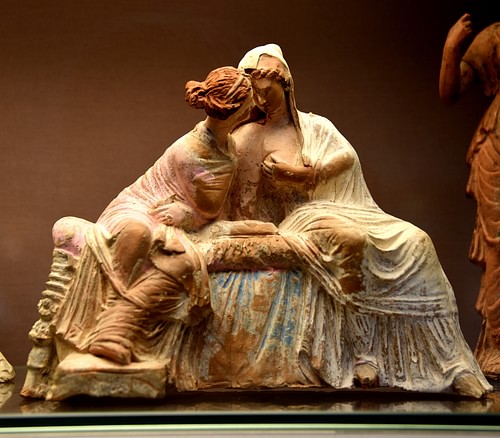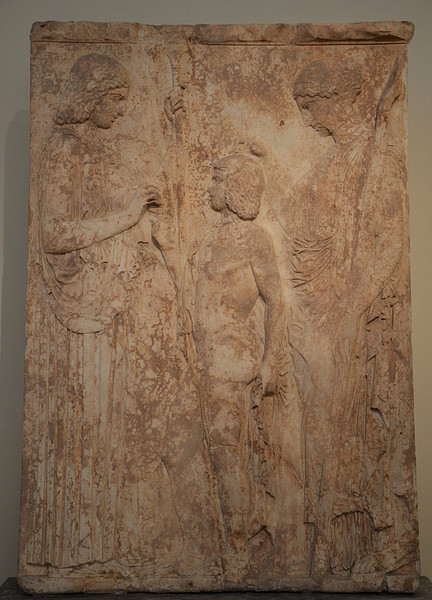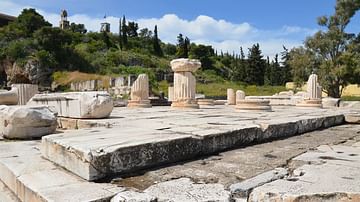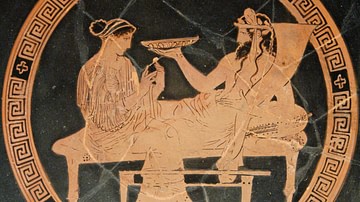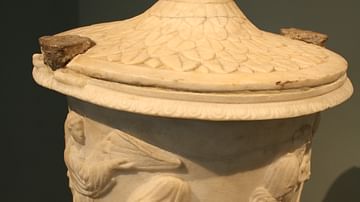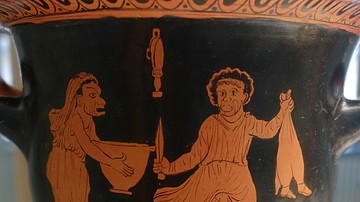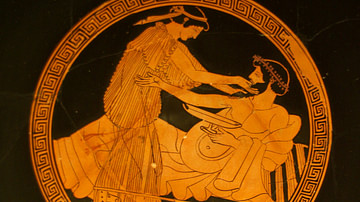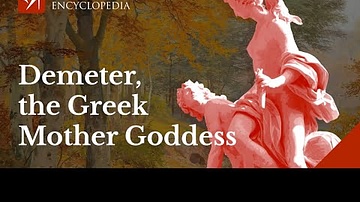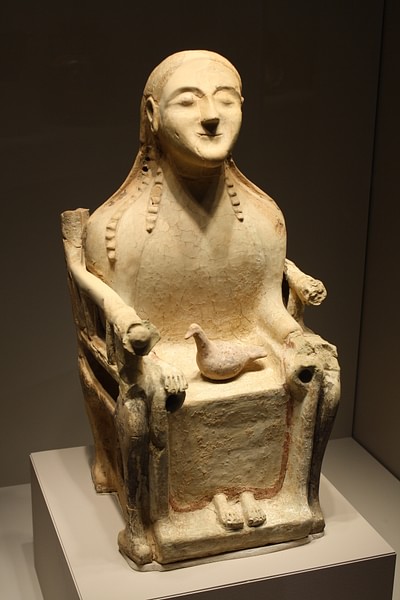
Demeter was one of the oldest gods in the ancient Greek pantheon. Demeter was a goddess of agriculture and guaranteed the fertility of the earth. She protected both farming and vegetation. The close connection with the earth was inherited from Demeter's mother Rhea. Demeter was probably a reincarnation of local mother Earth goddesses worshipped in rural communities in Bronze Age Greece.
The sanctuary at Eleusis is dedicated to both the goddess and her daughter Persephone. This was the location of the famous Eleusinian Mysteries. From Eleusis, the idea spread across the Archaic and Classical Greek worlds that Demeter would protect her worshippers in the afterlife. To the Romans, the goddess remained popular and was known as Ceres.
Demeter's Family
Daughter of Kronos and Rhea, sister of Zeus, Poseidon, Hades, Hera, and Hestia, Demeter was the mother of Persephone and Iacchus (both with Zeus) and Plutus, the god of wealth (with the mortal Cretan Iasion, who was subsequently killed by a thunderbolt from a jealous Zeus). She also adopted Demophon, the Eleusinian prince, who gave the human race the gifts of the plough and knowledge of agriculture. Demeter was also pursued by Poseidon, and to escape his attentions, she changed into a mare; however, Poseidon too changed into a horse and their resulting offspring was Arion, the winged horse ridden by Hercules. Demeter and Persephone were very often paired together and sometimes even referred to as a single goddess with a dual aspect. The duo was often referred to as 'the Two Goddesses' and the Demeteres (two Demeters).
Demeter & Persephone
The most important mythology surrounding Demeter was the story of the rape of her daughter Persephone (also known as Kore in Greek and Proserpina by the Romans) by Hades, the god of the Underworld. One day Hades fell in love with Persephone as soon as he saw her and so carried her off in his chariot to live with him in Hades, the Greek underworld. In some accounts, Zeus had given his consent to the abduction, the location of the crime being traditionally placed in either Sicily (famed for its fertility) or Asia. Distraught, Demeter searched the earth for her lost daughter and though Helios (or Hermes) told her of her daughter's fate, she, nevertheless, continued her wanderings until she finally arrived at Eleusis. It was here, disguised as an old woman, that the goddess cared for Demophon (or Triptolemus), the only son of Metaneira, the wife of Keleos (or Celeus), king of Eleusis. To reward the family for their kindness, Demeter set about making Demophon immortal by placing him on a fire every night. However, when Metaneira saw this she raised an alarm. In response, Demeter revealed her true identity and demanded a temple be built in her honour. This was the beginning of the celebrated sanctuary of Eleusis in Attica (see below).
Once the temple was completed, Demeter withdrew from the world and lived inside it; at the same time, she created a great drought to convince the other gods to release Persephone from Hades. As the drought claimed ever more victims, crops withered (illustrating Persephone's mastery over agriculture), and there was so little food that mortals could not even offer their sacrifices to the gods, Zeus finally persuaded Hades to release his ill-gotten bride. Before giving her up though, the wily Hades put a pomegranate kernel in the girl's mouth, knowing its divine taste would compel her to return to him. In other versions of the myth, Persephone could have been released if she had not eaten anything in the underworld during her captivity, but at the last moment, Hades gave her a pomegranate seed. Finally, as a compromise, it was decided that Persephone would be released but that she would have to return to Hades for one-third of the year (or in other accounts one half). In gratitude for the return of her daughter, Demeter was said to have sent the prince Demophon to teach humanity the cultivation of grain and other tricks useful for agriculture.
Demeter & the Eleusinian Mysteries
The story of Demeter and Persephone was perhaps symbolic of the changing seasons and the perennial change from life to death, to life once more, or, in other words, the changes from summer to winter and the return of life in spring. An alternative view of more modern historians is that the disappearance of Peresphone is symbolic of the practice of burying seeds in the summer so that they did not dry out before they could be sown in the autumn. The cycle became one of the rituals of the sacred Eleusinian Mysteries; indeed the symbols of the cult were ears of grain and a torch - symbolic of Demeter's search for Persephone and a reminder that the rituals at Eleusis were carried out at night.
Eleusis became the most important sanctuary to Demeter, and the site has a religious connection and related monuments dating back to the Mycenaean civilization of the 15th century BCE. From c. 600 BCE the Eleusinian Mysteries became an official ceremony in the Athenian calendar, and Eleusis became a truly pan-Hellenic site under the Athenian dictator Peisistratus (r. 550-510 BCE). In the 5th century BCE Pericles, the Athenian statesman (l. 495-429 BCE), oversaw the construction of a new Telesterion (Initiation Hall and temple), then the largest building in Greece. The site continued to attract pilgrims and worshippers well into Roman times with emperors Hadrian (r. 117-138 CE) and Marcus Aurelius (r. 161-180 CE) aggrandising Eleusis. The sanctuary's fortunes declined significantly following the decree of Theodosius I (r. 379-395 CE) to close down all pagan sites in 379 CE, and Eleusis was destroyed around 395 CE following the invasion of the Visigoths.
Unfortunately for us today, because all initiates were bound by a sacred oath not to reveal details of the Eleusinian Mysteries, they have to this day remained just that, a mystery. We do know that, from the 6th century BCE, the ceremonies were held twice a year. The first step in the initiation process was known as the "Lesser Mysteries" and held every spring. The more important "Great Mysteries" were held in the autumn over nine days. Only Greeks could be initiated, although this was later expanded to include Roman citizens. We also know details of some of the outdoor activities, and there was a procession led by the priestess of Demeter along the Sacred Way from Eleusis to the agora of Athens and another return procession led by a symbolic chariot of Iacchus. There were ritual and communal cleansing and purification ceremonies carried out in the sea at Phaleron, the representation or re-enactment of the myths involving the two goddesses, animal sacrifices (pigs), and the interpretation of sacred texts by priests, the mystagōgoi. There was also probably drinking, music, dancing, and general revelry involved, as attested by Greek pottery scenes of the rites which show initiates holding the "bacchus" or sacred rod. Closely associated with fertility and agriculture, the mysteries probably brought worshippers good fortune and, perhaps most important for most participants, the promise of a better afterlife.
Other Places of Demeter Worship
Demeter had sanctuaries across the Greek world in most city-states. Homer mentions that the goddess had a precinct named after her at Pyrasos. From the 8th century BCE there was a particularly noted sanctuary and temple to Demeter on Naxos. In the 4th century BCE, a temple was constructed in her honour at Dion. Other notable sites of worship included Andania in Messenia, Lykosoura in Arcadia, and, perhaps most curiously, at Phigaleia, also in Arcadia, where a cult statue of the goddess was placed in a cave which had a horse's head, probably in reference to Demeter's amorous encounter with Poseidon. Many southern Italian city-states, especially in Sicily, had important cults to Demeter where she was often associated with civic duties, a link also seen in her worship at Thebes.
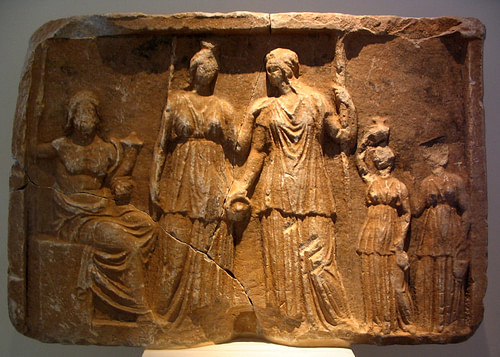
Besides the mystery cult, at Eleusis during the Archaic and Classical periods there was the Eleusinia, an important biannual games where the prizes were sacred grain. The Thesmophoria, meanwhile, was an all-female autumn festival in Attica to honour Demeter. Designed to generally promote fertility, the festival saw pigs thrown into pits or caves and left to putrefy; their remains were then mixed with seeds before sowing. Although not particularly informative about the festival itself, Aristophanes (c. 460 - c. 380 BCE), the master of Greek comedy, wrote the play Thesmophoriazusae (411 BCE) where, during the festival, women take advantage of the traditional exclusion of men and debate the elimination of Euripides (c. 484-407 BCE), one of the great writers of Greek tragedy. There was, too, the Haloa, another largely all-female winter festival in honour of Demeter and Dionysos, the Kalamaia, and the Proerosia festivals.
How is Demeter Represented in Art?
In ancient literature, Homer in The Iliad describes the goddess as 'golden-haired', and Hesiod in his Theogony and Works & Days, describes her as 'bounteous Demeter', 'well-garlanded', 'hallowed', and 'reverend'. Demeter rarely appears in the visual arts before the 6th century BCE and then she is usually shown with Persephone. In Archaic and Classical art she is often seated, wears a crown of grain and holds a torch (signifying her search for her lost daughter) or a sceptre, a poppy (the flower that grows so abundantly in untended wheat fields) or simply stalks of grain. In her role as a goddess of fertility, Demeter is also sometimes present in scenes depicting the birth of Athena. From Eleusis, there are surviving relief panels showing both Demeter and Persephone which once adorned the sacred buildings at this her most important sacred site.
